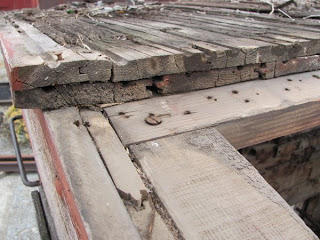In the interest of arresting further deterioration of the car, it was decided to remove the original but heavily damaged roofing, and replace it with a temporary winter roof. Very few Sumpter Valley Railway cars were fitted with metal roofs, the most notable exceptions on the home-built rolling stock were the caboose cars. The standard for freight cars was a double layer tongue and groove, appears to be fir, with dual drain channels and a tar paper layer in between. Thanks to a relatively mild climate, this style of roof is surprisingly durable, with many cars remaining acceptably weather tight after more than 60 years in the elements. Regardless, over a couple days, all the old roofing, along with an estimated 1570 nails, was removed from the 1353. The roof framing had minimal rot, and easily supported the crew working on the car. It is unlikely that any of the stringers or ribs will need replacement.
Samples of the roofing were documented and set aside for preservation as they will be necessary when the original wooden roof is replicated in the near future.
























